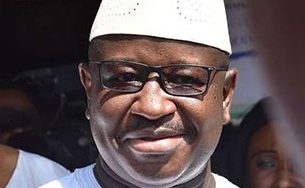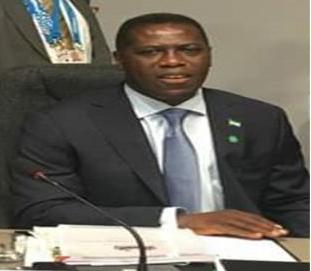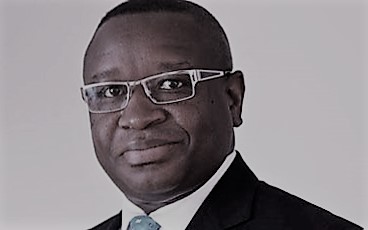Lawyers Get Their Final Say at the Charles Taylor Trial
In tailored suits and with gold cufflinks matching his gold-rimmed glasses, Charles Taylor has spent much of the past three years sitting largely impassively in a courtroom in The Hague, occasionally writing notes to his lawyers, and listening as witnesses described tales of horror to a panel of judges. Prosecutors say the former Liberian president is responsible for the mayhem and crimes committed by rebels in his neighboring country, Sierra Leone.
The exception was the almost seven months when Taylor took the stand in his own defense, when he was animated, usually chatty and personable, at times flashing anger, as he told his side of the story. He and many of the witnesses who spoke in his defense tried to refute the accusations and tell an entirely different story—one of an innocent peacemaker turned scapegoat at the whim of western powers. (The Open Society Justice Initiative has been tracking developments in the case on its monitoring site, CharlesTaylorTrial.org.)
On February 8, prosecutors will have one final chance to convince the judges of Taylor’s guilt. On February 9, Taylor’s own defense lawyers will aim to persuade the bench that their client was not responsible for the horrific violence—murders, rapes, hacked off limbs, and looting—committed by rebels during Sierra Leone’s bloody 11-year civil war.
The closing arguments mark the end of three years of testimony before the Special Court for Sierra Leone, the UN-backed court which normally operates out of the West African country’s capital, Freetown. The Taylor trial was moved to The Hague on instruction by the UN Security Council because of security concerns.
After an initial false start in July 2007 when Taylor failed to appear for the opening of the case and fired his lawyers, the case began in earnest—with a new set of lawyers—in January 2008.
The case against Taylor alleges that he was involved in a criminal plan with Sierra Leonean rebel leader, Foday Sankoh, which aimed to seize control of the country’s resources and territory. Prosecutors say Sankoh and Taylor first formed this plan back in the 1980s, when they were both at a revolutionary training camp in Libya, hosted by Libyan President Muammar Ghaddafi. Taylor and Sankoh then allegedly set out on a campaign of terror that ended, finally, in 2002. The violence was fueled in large part by Sierra Leone’s diamond wealth. Sankoh’s group, the Revolutionary United Front, (RUF) would allegedly bring Taylor diamonds from Sierra Leone and, in exchange, Taylor would supply the rebels with the arms and ammunition used to perpetrate crimes.
Taylor had such influence over the rebels, prosecutors say, that he was effectively the RUF commander. As such, they say he should be held responsible for its crimes, because he should have known about them, was in a position to prevent them, or punish people for them, and yet failed to do so. For his role in planning, ordering, instigating, aiding and abetting the commission of crimes, prosecutors say, Taylor bears the greatest responsibility for the conflict.
In closing argument, prosecutors will likely make these points:
- Taylor created and controlled the RUF, first by assisting with their training in Liberia and then by providing manpower to fuel the invasion of Sierra Leone in 1991.
- Taylor contributed to the crimes in Sierra Leone by stocking the rebels’ arsenal with arms and ammunition.
- Taylor played a role in looting diamonds from Sierra Leone by providing the RUF with materials and specific instructions to control the diamond mines in the country.
- With his influence and leadership over the RUF, Taylor had knowledge of RUF crimes in Sierra Leone but failed to prevent and punish the crimes committed.
- Taylor used his influence and leadership to send RUF surrogates to attack neighboring Guinea and as well as opposing rebel forces in Liberia in an effort to consolidate control and influence in the region.
- Taylor hid himself under the cloak of a peacemaker and tried to conceal his role in the crimes by eliminating people who knew about his relationship with the Sierra Leonean rebels. Those executed on Taylor’s orders included high level RUF commanders.
- The Sierra Leonean rebel group was basically an extension of Taylor’s own rebel group in Liberia. Fighters from both groups crossed into each other’s territory and provided needed support. The two groups had one leader—Charles Taylor.
The defense has steadfastly rejected the allegations against Taylor. Wanting to bring stability to the region, they argue, Taylor acted at the behest of West African states and the United Nations to broker peace between the warring factions in neighboring Sierra Leone. He also negotiated with rebels to free abducted United Nations peacekeepers and ushered one of the most prominent rebel leaders out of Sierra Leone to help calm the conflict.
The defense argues that Taylor’s trial is “political” because others—such as then Sierra Leonean president, Ahmed Tejan Kabbah—bore the greatest responsibility for the crimes. But Taylor’s role in the conflict, they claim, has been skewed to suggest he was the one most responsible for the atrocities. The defense also maintains that Taylor’s indictment suited western powers, such as the United States and United Kingdom, who wanted “regime change” in Liberia.
Throughout the trial, Taylor was defended by a charismatic Jamaican-born British barrister, Courtenay Griffiths, who speckled his opening statement with Bob Marley lyrics. (Griffiths accused the case’s first prosecutor of “working iniquity to achieve vanity.”)
Taylor‘s defense will likely make the following key points:
- Taylor was a peacemaker whose dealings with the Sierra Leonean rebel group, RUF had the blessings of other West African leaders, who gave him a mandate to help bring the conflict in Sierra Leone to an end by peaceful means.
- RUF commanders probably had dealings with members of Taylor’s security apparatus, but these relationships were not with Taylor’s knowledge and support.
- The West African region had become so rife with conflict, resulting in different factions controlling territory along Sierra Leone’s and Liberia’s borders, and allegations that Taylor could easily send arms and ammunition from Liberia to Sierra Leone are fanciful.
- RUF commanders in fact had wide ranging sources of support and were not solely reliant on arms and ammunition from Liberia. The RUF bought materials from others including Taylor’s own NPFL rivals the United Liberation Movement for Democracy (ULIMO), Guinean soldiers, the Burkinabe army, and even Economic Community of West African States Monitoring Group (ECOMOG) peacekeepers..
- The prosecution case has not been proven without reasonable doubt. It is riddled with inconsistencies and internal contradictions which put the credibility of its witnesses in doubt. Furthermore, many linkage witnesses testified against Taylor because they were induced by money or other benefits from the Prosecution. Some were also relocated to Western countries because of their testimonies
- Taylor is on trial because of a conspiracy by Western countries like the United States of America and Britain who want to keep him out of Liberia.
During the three-year proceedings, a total of 115 witnesses testified, the last in November 2010. Of those, 94 spoke for the prosecution and 21 witnesses testified for the defense.
Among the most high profile were supermodel Naomi Campbell and actress Mia Farrow, who were brought in by the prosecution in an attempt to show that Taylor was knowingly trading weapons in exchange for diamonds. Allegations that Taylor sent rough cut diamonds to Campbell after a star-studded dinner in 1997, hosted by former South African president, Nelson Mandela, were used by prosecutors to try to link Taylor to the diamonds themselves and then to a weapons shipment that landed in Sierra Leone a month later. (Taylor said he never possessed diamonds during his presidency beyond his personal jewelry and that he had nothing to do with the shipment.)
After next week’s closing arguments, the Court will issue its judgment, expected before the end of 2011. The judgment will determine whether enough evidence was presented to find Taylor guilty on each of the 11 counts of war crimes, crimes against humanity and other serious violations of international humanitarian law. (Taylor is presumed innocent until proven otherwise, and it is the burden of the prosecutor to prove his guilt beyond reasonable doubt before judges can make a decision to convict.)
If Taylor is convicted of any or all of the charges, the Special Court for Sierra Leone will then hold a hearing to determine Taylor’s sentence. Under the terms of the Court’s statute, any prison sentence must be for a specific number of years. The United Kingdom has offered to imprison Taylor if he is found guilty. If Taylor is found not guilty, he will be acquitted and released as a free man.
No matter what the trial judgment, an appeal of the case by one or both sides is likely. The court’s Appeals Chamber then will decide on those points of appeal. An appeals judgment, if a challenge is filed, is likely to be handed down sometime in 2012.
Alpha Sesay
Stay with Sierra Express Media, for your trusted place in news!
© 2011, https:. All rights reserved.






